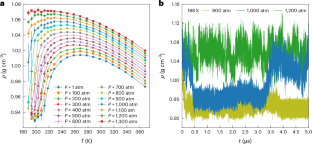2025-03-03 中国科学院
<関連情報>
- https://english.cas.cn/newsroom/research_news/life/202503/t20250303_902886.shtml
- https://www.science.org/doi/10.1126/science.ads0377
広範な植物防御化合物が細菌のIII型インジェクティソーム集合体を無力化する A widespread plant defense compound disarms bacterial type III injectisome assembly
Pei Miao, Haijun Wang, Wei Wang, Zhengdong Wang, […], and Xiaoguang Lei
Science Published:28 Feb 2025
Editor’s summary
The type III secretion system (T3SS) is used by bacterial species to inject effector proteins into host cells. However, the mechanisms of host-mediated blockage of virulence, especially by metabolites, are not well understood. Miao et al. uncovered a phytoalexin called erucamide that is produced by several plant species and blocks T3SS function in two bacterial species. The target of erucamide is the conserved bacterial type III secretion system syringe protein HrcC. Erucamide accumulation is part of plant defense, and transgenic plants with reduced erucamide were found to be susceptible to bacterial infection. —Ankit Walia
Structured Abstract
INTRODUCTION
Plants employ immune receptors to perceive pathogen-associated molecular patterns (PAMPs) to trigger immune signaling. How plants impede pathogen progression following successful signal transduction, however, has remained largely elusive. Plants produce diverse secondary metabolites, called phytoalexins, in response to pathogen infections. Various phytoalexins show strong lineage specificity and are believed to act upon microbes by growth inhibition or toxicity. Whether any phytoalexins protect plants by targeting specialized virulence machinery of pathogens has not been well studied. For instance, numerous gram-negative bacterial pathogens employ the type III secretion system (T3SS), a multiprotein injectisome, to deliver virulence proteins into animal and plant host cells for pathogenesis. Immune-activated plants are known to possess activity that inhibits the bacterial T3SS, although the nature of this activity and underlying mechanism remain unknown. This immune-induced anti-T3SS activity serves as a model to investigate potential antivirulence phytoalexins in plants.
RATIONALE
We hypothesized that immune-activated plants accumulate metabolite(s) that inhibit bacterial T3SS. Such knowledge will not only add a new dimension to our understanding of the plant immune system but also shed light on the future development of biopesticides. We set out to identify plant metabolite(s) that could inhibit bacterial T3SS in vitro, determine the biological importance of such metabolite(s), and elucidate the mechanism underlying T3SS inhibition.
RESULTS
We found that crude extracts of Arabidopsis leaves inhibit Pseudomonas syringae effectors secretion through T3SS. Activity-guided purification identified erucamide as a broad-spectrum inhibitor against T3SS secretion of diverse bacterial pathogens of plants and animals. We found that erucamide is a lineage-nonspecific phytoalexin of both dicot and monocot plant species, induced by PAMPs and suppressed by virulent P. syringae DC3000. At physiological concentrations equivalent to those determined in immune-activated Arabidopsis plants, exogenously applied erucamide strongly protected plants against DC3000. Pathway analysis indicated that 3-ketoacyl-CoA synthases (KCSs) are required for erucamide synthesis and fatty acid amide hydroxylase (FAAH) could degrade erucamide in Arabidopsis. Arabidopsis kcs mutants and FAAH-OE lines were significantly impaired in the immune-induced accumulation of erucamide, and these plants were severely compromised in antibacterial immunity normally induced by PAMPs. Exogenous application of erucamide to these plants restored their antibacterial immunity. Conversely, faah mutants accumulated more erucamide and exhibited significantly enhanced antibacterial immunity. Profiling of P. syringae proteins identified HrcC, an outer membrane ring structure protein that is essential for injectisome assembly, as a target of erucamide. AlphaFold prediction, molecular docking, molecular dynamics simulation, and site-directed mutagenesis identified an erucamide-binding pocket composed of five amino acid residues highly conserved in the HrcC of diverse bacterial species. We additionally identified a mutation in HrcC that abolished erucamide binding and rendered the bacterium insensitive to erucamide, regarding T3SS secretion and virulence on plants with varying levels of erucamide accumulation. Furthermore, structure-activity analyses of erucamide analogues showed that the amide group, position of the double bond, and alkyl chain length play crucial roles in the T3SS-inhibitory activity. Unlike erucamide, analogues that do not inhibit T3SS neither bind HrcC nor protect plants from virulent bacteria.
CONCLUSION
We identify erucamide as an ancient, broad-spectrum, antivirulence phytoalexin that selectively disarms the T3SS injectisome of diverse bacterial pathogens. Our results suggest that erucamide binds a pocket composed of invariant residues essential for injectisome function. The elucidation of enzymes involved in the biosynthesis and degradation of erucamide may help engineer crop plants with increased immunity against various bacterial pathogens. The information about the structure-activity relationship of erucamide analogues may shed light on the future development of eco-friendly antibacterial pesticides. Our work additionally uncovers a contest between erucamide accumulation in Arabidopsis and effector secretion by P. syringae. Although successful induction of erucamide can prevent bacterial T3SS secretion, the rapid secretion of bacterial effectors can dampen erucamide accumulation in plants. The speed of these two processes may be crucial for the disease resistance/susceptibility outcomes of plant-bacterial interactions.

Working model of erucamide-mediated defense.
Erucamide directly binds HrcC, a ring-structure protein shared by numerous bacteria, to disrupt the assembly of the T3SS injectisome, thereby inhibiting the virulence of pathogenic bacteria. [Image created using BioRender]
Abstract
Numerous gram-negative bacterial pathogens employ the type III secretion system (T3SS), a multiprotein injectisome, to deliver virulence proteins into host cells and cause diseases. We uncover erucamide as a previously unknown phytoalexin of both dicots and monocots that blocks the T3SS function of multiple bacterial pathogens. Genetically impairing erucamide accumulation or exogenous application in Arabidopsis highlighted erucamide’s role in antibacterial immunity. Erucamide binds Hypersensitive response and conserved C (HrcC), a key T3SS component, to block injectisome assembly. Analyses of erucamide analogs and HrcC mutants indicated that the erucamide-HrcC binding is required for inhibiting T3SS in vitro and antibacterial resistance in plants, suggesting an essential role of erucamide-HrcC binding in disease resistance. This work reveals a plant chemical defense that targets major virulence machinery in bacterial pathogens.



